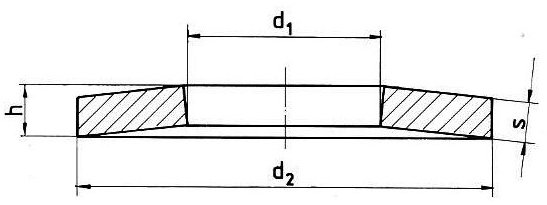BELLEVILLE WASHERS DIN 6796
They are also referred to “belleville” washers or “spring washers”. These pieces are manufactured according to DIN 6796 and they are conical washers made from steel or other alloys with elastic characteristics, which offer high resistance to axial loads.
It is necessary to remark the difference between belleville washer DIN 6796, that are pieces that are manufactured only for static applications (mainly in metric sizes), and belleville spring washers, that support static and also dynamic applications.
The design and manufacture method of these washers make them offer great forces in short travels. It should never be forgotten that their elastic capacity is limited. This is why they are appropriate to work under static loads, where they can maintain the pressure over time. On the other hand, they should never be used in works with dynamic loads, as their recovery capacity is not sufficient.
The main application of these elements is to secure screwed joints, maintaining constant tension between them. Temperature variations and vibrations may produce expansion or contraction in the joint between the screw and nut, which produces the joint loosening over time. The force generated in the screw joint by the washer once compressed maintains a tension that compensates those effects and avoids the total loss of tension, maintaining a firm and stable joint between the screw and nut over time.
In the table below, a list of catalogue standard washers according to DIN 6796 and a list of usual materials and coatings for these pieces are shown. There is also and explanation of the table values, main materials and coatings.
Apart from standard measures, washers with special dimensions can be manufactured:
Table values
- Nominal bolt size: Diameter of the screw or bolt suitable for this washer
- d1: Internal diameter with H14 tolerance
- d2: External diameter with H14 tolerance
- s: Washer thickness with tolerances according to DIN 6796
- hmax: Initial maximum height of the piece
- hmin: Minimum height of the piece after the first compression
- Flattening force: Force in Newtons of the washer when being flattened
- Residual spring force: Minimum guaranteed force in Newtons in the joint
Note about force: “Flattening force” and “Residual spring force” values in the table are not exact. DIN 6796 washers are not provided with the precision other springs have. They are products working at high level of tensions and whose function is to offer high force in elastic works. These force values are aimed at providing the user with some guidance about DIN 6796 washer effectiveness with regards to maintaining the axial load in screwed joints. A common measure of lengthening in this type of joints is between 5 and 10μm. In order to avoid inaccuracies due to material roughness and thickness of the surface protection, the residual force is measured 20 μm before the total compression (washer at flat state). Therefore, the value of residual force shown in the tables represents the minimum value we can find in practice, which allows to ensure that an exceptionally high contact force value between the pieces will be obtained and therefore a safe joint.
Materials and coating
The standard material for these pieces according to the regulations is C60 steel with a hardness level from 420 to 510 HV. Stainless steels and nickel alloys like Inconel are also used when corrosion or temperature conditions make it necessary. It should be considered that, due to the different elasticity module of these materials, the force level of the washer will be lower. An alternative to the use of special materials is the use of coatings. This is a more economical solution and it is often a sufficient protection for the pieces. It is worth noting that it can be even more effective than special materials in certain environment. Zinc coating is one of the most effective.

